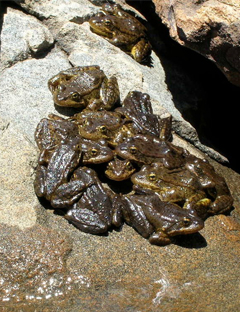New insights into frog-killing disease
May 12, 2010 -- As a deadly disease continues to wipe out frog populations across the globe, Assistant Professor of Biology Vance Vredenburg has discovered new insights about how the disease spreads and kills. His findings offer hope for how frogs might be saved from the epidemic.
Vredenburg spent 13 years tracking the invasion and spread of the disease, known as chytrid, among mountain yellow-legged frogs in the Sierra Nevada Mountains. He found that a key factor that determines whether frog populations will survive or succumb to the disease is infection intensity -- how much of the disease is in individual frogs.

Assistant Professor of Biology Vance Vredenburg collects a skin swab from a southern mountain yellow-legged frog. His research suggests that mass frog deaths from the fungal disease chytrid only tend to occur once infection intensity reaches an average of more than 10,000 fungal spores per skin swab.
"We found that mass frog die-offs only occur when the severity of the chytridinfection reaches a critical threshold among the individual frogs," said Vredenburg, whose research was recently published in two papers in the Proceedings of the National Academy of Sciences. "Now that we know this limit, which is a specific number of fungal spores per frog, conservation efforts may be able to save susceptible frog species by preventing the disease from reaching this point."
As well as identifying the dangerous threshold, beyond which chytrid causes
death and extinction, Vredenburg also found that continual re-infection with
the fungus causes the disease to escalate to this point.
Chytrid is caused by an aquatic fungus that lodges in frogs' skin, and the
disease has already driven more than 200 frog species to extinction.
Extinction versus survival
Vredenburg and colleagues also found evidence that helps explain why the disease drives some frog populations to extinction, while other frogs survive with the disease for years. The researchers compared frog populations in Sequoia Kings Canyon National Park, where chytrid has swept through lakes and has almost eliminated mountain yellow-legged frogs in the last five years, to frogs in Yosemite National Park, where the disease has been present for more than a decade and a smaller number of frogs have been living with the infection.
Again, infection intensity explained why some frogs survive and others don't. The adult frogs in Yosemite were infected with only low-level infections and individuals were found to lose and regain the infection over time.

A huddle of southern mountain yellow-legged frogs in California's Sierra Nevada. Professor Vance Vredenburg's research suggests that high population densities in frog communities could promote re-infection among frogs, causing the intensity of the disease to reach dangerously high levels.
Solutions to save frogs
Vredenburg's results suggest that targeting re-infection rates could save frogs from mass extinction caused by chytrid.
An unusual feature of chytrid, which makes it particularly virulent, is that it cannot replicate on a frog's body in the same way as cancer or a viral infection. A key part of the chytridgrowth lifecycle involves a swimming fungal spore that must either re-infect the same frog host after it is released outside the body or find a new host to continue growing.
One way to limit the severity of the disease could be to reduce frogs' population density, since Vredenburg's surveys suggest that frogs help re-infect each other through contact. Other conservation measures could include treating individual frogs with anti-fungal compounds, or probiotics, or temporarily removing tadpoles. Such interventions could lower infection intensity and allow some frogs to survive an epidemic.
"These results are about more than just frogs," Vredenburg said. "They are about disease, how and why it spreads and how some populations can be wiped out by a disease while others survive. This is important to all of us considering that 60 percent of emerging diseases in humans come from wildlife. The models we have provided may be adapted by ecologists to better understand similar diseases that affect humans or cattle or corn, for example."
-- Elaine Bible
Share this story:
